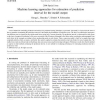Free Online Productivity Tools
i2Speak
i2Symbol
i2OCR
iTex2Img
iWeb2Print
iWeb2Shot
i2Type
iPdf2Split
iPdf2Merge
i2Bopomofo
i2Arabic
i2Style
i2Image
i2PDF
iLatex2Rtf
Sci2ools
NN
2006
Springer
2006
Springer
Machine learning approaches for estimation of prediction interval for the model output
A novel method for estimating prediction uncertainty using machine learning techniques is presented. Uncertainty is expressed in the form of the two quantiles (constituting the prediction interval) of the underlying distribution of prediction errors. The idea is to partition the input space into different zones or clusters having similar model errors using fuzzy c-means clustering. The prediction interval is constructed for each cluster on the basis of empirical distributions of the errors associated with all instances belonging to the cluster under consideration and propagated from each cluster to the examples according to their membership grades in each cluster. Then a regression model is built for in-sample data using computed prediction limits as targets, and finally, this model is applied to estimate the prediction intervals (limits) for out-of-sample data. The method was tested on artificial and real hydrologic data sets using various machine learning techniques. Preliminary res...
| Added | 14 Dec 2010 |
| Updated | 14 Dec 2010 |
| Type | Journal |
| Year | 2006 |
| Where | NN |
| Authors | Durga L. Shrestha, Dimitri P. Solomatine |
Comments (0)

